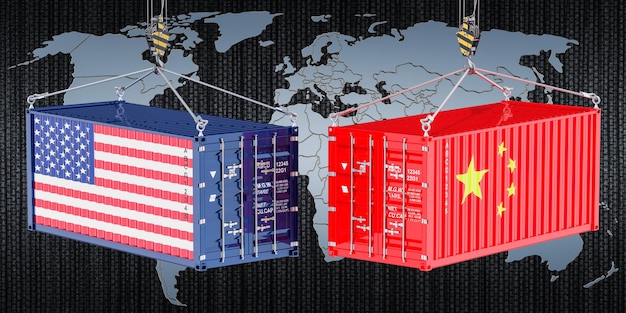Trump’s China Trade Tariffs: Impact on US Consumers

The Trump administration’s stance on China trade, primarily through the imposition of tariffs, significantly impacted US consumers by raising prices on imported goods, affecting various sectors, and prompting retaliatory measures that influenced the overall economic landscape.
The Trump Administration’s stance on China trade: How will the latest tariffs affect US consumers? is a question that has resonated deeply within the American economy. Understanding the nuances of these policies is crucial for consumers and businesses alike.
Understanding the Trump Administration’s Trade Policy with China
The Trump administration initiated a series of trade policies aimed at addressing what it perceived as unfair trade practices by China. These policies primarily involved the imposition of tariffs on a wide range of Chinese goods, sparking a complex economic relationship between the two nations.
Key Objectives of the Trade Policy
The Trump administration’s trade policy had several objectives, including reducing the trade deficit with China and encouraging China to change its intellectual property practices and other trade behaviors.
Specific Tariffs Imposed
The tariffs imposed covered a vast array of products, from steel and aluminum to consumer goods like electronics and clothing.
- Initial Tariffs: Early tariffs focused on specific sectors like steel and aluminum.
- Expanded Tariffs: Later, the tariffs were expanded to cover thousands of additional products.
- Retaliatory Measures: China responded with its own tariffs on US goods, particularly agricultural products.

These tariffs were intended to incentivize China to negotiate more favorable trade terms with the United States, but they also had significant consequences for American consumers and businesses.
The Immediate Impact on US Consumers
The immediate impact of these tariffs was seen in the rising prices of imported goods. As tariffs are essentially taxes on imports, the cost was often passed on to consumers.
Price Increases on Consumer Goods
Many everyday consumer goods, from electronics to clothing, experienced price increases as a direct result of the tariffs.
How Tariffs Affect Different Income Groups
The impact of these price increases was not uniform across all income groups. Lower-income households, who spend a larger portion of their income on basic goods, were disproportionately affected.
- Lower-Income Households: Faced a greater burden due to increased prices on essential goods.
- Middle-Income Households: Experienced moderate increases in the cost of living.
- Higher-Income Households: Felt the impact less due to their greater financial flexibility.
The tariffs reduced purchasing power for many American families, affecting their ability to afford essential goods and services.
Sector-Specific Impacts of the Tariffs
Certain sectors of the US economy were particularly vulnerable to the effects of the tariffs. These sectors include retail, agriculture, and manufacturing.
Retail Sector
The retail sector was significantly affected, as retailers had to either absorb the cost of the tariffs or pass it on to consumers.
Agricultural Sector
The agricultural sector faced challenges as China retaliated with tariffs on US agricultural products, reducing exports and impacting farmers’ incomes.
Manufacturing Sector
The manufacturing sector saw mixed effects, with some manufacturers benefiting from reduced competition from Chinese imports, while others faced higher costs for imported components.

These sector-specific impacts illustrate the complexity of the tariffs’ effects on the US economy.
The Broader Economic Consequences
Beyond the immediate effects on consumers and specific sectors, the tariffs had broader economic consequences, influencing inflation, economic growth, and international relations.
Impact on Inflation
The tariffs contributed to inflationary pressures in the US economy, as increased import costs led to higher prices for many goods.
Effects on Economic Growth
The tariffs had a dampening effect on economic growth, as they reduced trade, increased uncertainty, and disrupted supply chains.
International Relations
The trade dispute strained relations between the United States and China, creating tensions that extended beyond trade to other areas of international cooperation.
- Trade Negotiations: The tariffs were used as leverage in trade negotiations between the two countries.
- Global Trade: The dispute affected global trade patterns and influenced the behavior of other nations.
- Supply Chains: Many companies reconsidered their supply chains due to the uncertainty created by the tariffs.
Despite efforts to mitigate these economic consequences, the tariffs had a notable impact on the overall economic health of the United States.
Potential Long-Term Effects
The long-term effects of the tariffs are still being assessed, but they could include changes in consumer behavior, shifts in global supply chains, and lasting impacts on the US-China relationship.
Changes in Consumer Behavior
Consumers may adapt to the higher prices by changing their purchasing habits, seeking out alternative products, or reducing their overall spending.
Shifts in Global Supply Chains
Companies may move their supply chains out of China to avoid the tariffs, leading to shifts in global manufacturing and trade patterns.
Lasting Impacts on the US-China Relationship
Given the significant role China plays in the world economy a tense relationship between both countries could linger for years to come.
These longer-term effects emphasize the critical need for policymakers and businesses to fully understand and adapt to the changing global economy.
Strategies for Consumers to Mitigate Tariff Impact
Despite the challenges posed by the tariffs, there are several strategies that consumers can adopt to mitigate their impact on personal finances.
Comparison Shopping
Consumers can compare prices across different retailers and brands to find the best deals and minimize the impact of price increases.
Adjusting Consumption Habits
Consider reducing discretionary spending wherever possible.
Supporting Local Businesses
Supporting local businesses can benefit their community and also reduce one’s dependency on Chinese imports.
Implementing these strategies can help consumers manage the financial challenges posed by the tariffs and protect their purchasing power.
| Key Aspect | Brief Description |
|---|---|
| 📈 Price Increases | Tariffs led to higher prices on imported goods, affecting consumer spending. |
| 🌾 Agricultural Impact | US farmers faced reduced exports due to retaliatory tariffs from China. |
| 🛒 Consumer Strategies | Consumers can compare prices, adjust habits, and support local businesses. |
| 🌍 Supply Chains | Companies may shift supply chains from China to avoid tariffs. |
Frequently Asked Questions
▼
The tariffs were imposed primarily to address trade imbalances, protect intellectual property, and encourage fairer trade practices by China.
▼
The retail, agriculture, and manufacturing sectors were particularly vulnerable to the effects of the Tariffs.
▼
The tariffs increased the cost of imported goods, driving up consumer prices overall, especially impacting low-income households.
▼
The dispute strained relations between the United States and China as well as the behaviour of other nations.
▼
Consumers should compare prices, adjust habits, and support local businesses. Companies may shift supply chains from China.
Conclusion
In conclusion, the Trump administration’s tariffs on Chinese goods had a multifaceted impact on US consumers. While intended to address trade imbalances and unfair practices, the tariffs led to increased prices, sector-specific challenges, and broader economic consequences. Moving forward, understanding these effects is key for consumers and businesses to adapt to the evolving economic landscape.





